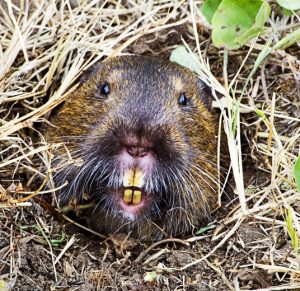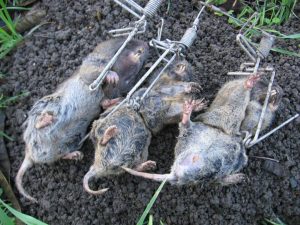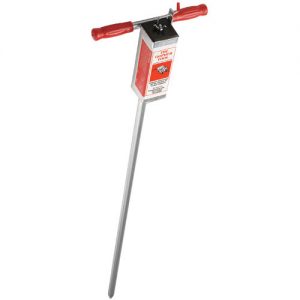Pocket gophers really are menaces to mountain gardens. These burrowing rats live  underground and destroy gardens by chomping plant roots and ruin soils by destroying worm counts and beneficial fungi. Their devastation includes decimating tree roots to the point that large trees can blow over in one of our powerful spring windstorms!
underground and destroy gardens by chomping plant roots and ruin soils by destroying worm counts and beneficial fungi. Their devastation includes decimating tree roots to the point that large trees can blow over in one of our powerful spring windstorms!
Recently, although far from funny, it was almost cartoon-like to watch a broccoli plant in my garden disappear “subterranean style” and vanish as though it had never existed. This is the classic effect of pocket gopher activity and why extermination must be brought onto the field of battle. Over the decades, as I’ve been dealing with these critters, I’ve learned that gas, traps, or poison are the only weapons for long-term solutions against these underground vermin.
Gopher gassers are miniature road flares that are stuck down into the rodents’ holes, ignited, and them buried. They are extremely effective if gopher activity is caught early, but woefully inadequate for large colonies of these buck-toothed wonders. If you have more than one mound rising in your landscape, you must move on to more drastic measures.
Gopher traps are the tried-and-true weapons of hard-core gardeners. They really work, but demand a lot of time and effort to get ahead and keep ahead of these subterranean marauders. At one point in my gopher killing career, 12 traps were set each morning and again at dusk. On average I killed 12 gophers per day for over a month before declaring victory. Anyway you do the math that’s a lot of rodents and a lot of traps set on one property! Keep in mind that you never have just one gopher but entire families of these pests relishing their destructive paths through your garden.
 Traps work, but are difficult to set down in the holes. If none of the enemy enters a trap within 24 hours my suggestion is to move the trap to another hole. When trapping is successful bury the carcass back in the hole where it met its demise.
Traps work, but are difficult to set down in the holes. If none of the enemy enters a trap within 24 hours my suggestion is to move the trap to another hole. When trapping is successful bury the carcass back in the hole where it met its demise.
If your garden looks like the aftermath of an air raid then it is time to break out the big guns. I know, because at times it seemed these pea-brained ground dwellers had out smarted me. That’s when I turned to the Gopher Probe, my ultimate weapon! This T-handled tool lets me administer a corn-laced attractant directly into the labyrinth of tunnels beneath the garden. Here’s my battle plan:
Step one – Knock down all existing mounds so you can see where the pocket gopher  currently is working. The average family of gophers has a house with many rooms that can expand over 150 square feet of garden and lawn.
currently is working. The average family of gophers has a house with many rooms that can expand over 150 square feet of garden and lawn.
Step two– Using the Gopher Probe, gently probe around each new mound until you feel the needle’s tip slip quickly into the ground. This indicates you have entered directly into the gopher’s realm. Use the tool’s ingenious handle to release the gopher killer under the soil’s surface. Hidden underground the gopher family feels safe to ingest the delicious corn-laced feed. Before morning they will feel under the weather and put themselves to bed never to return. This may seem harsh, but it’s the most effective way to deal with rodents, and your gopher problems are cured without ever witnessing a dead body. No bodies to deal with, no dead corpus smell, no fuss, and highly effective.
CAUTION – Zinc Phosphide is the poison you want to use with the Gopher Probe. Please, please, please stay away from strychnine baits. Strychnine is so dangerous that I would not dream of handling it, much less using it where my dogs and children run free, and where wild birds fly. Also, zinc phosphide does not keep on killing like strychnine does. The gopher eats the zinc, goes to bed, and never wakes. If a coyote should find the body and eat it, there is no secondary kill. Enough said.


You say “large colonies” of gophers; but they’re solitary varmints. So, it shows you actually don’t understand them. Or I don’t. One of us must be wrong.
There must be a reason this vermin reproduces so quickly? They may be solitary, but I find most properties have far more than one gopher on them. Really go after this garden pest and they can be eradicated. Ken
Our neighbor here in Mayer has planted castor bean plants and puts the resulting crop of beans down the gopher holes. It seems they do not like the plants and roots and they eat the beans and die. Haven’t tried it myself yet….no bean plants! 😎
Since you recommend using zinc phosphide as a less toxic alternative to strychnine, I looked it up. It is effective as a rodenticide, but it, too, is highly toxic to birds, fish, and mammals, including humans. Though the vomit reflex may lessen the effects of exposure, here is what I read: “Some symptoms of exposure to zinc phosphide and phosphine gas include headache, dizziness, vomiting, and difficulty breathing. Liver and kidney failure, convulsions,” delirium and coma may also occur if a person is exposed to enough phosphine.